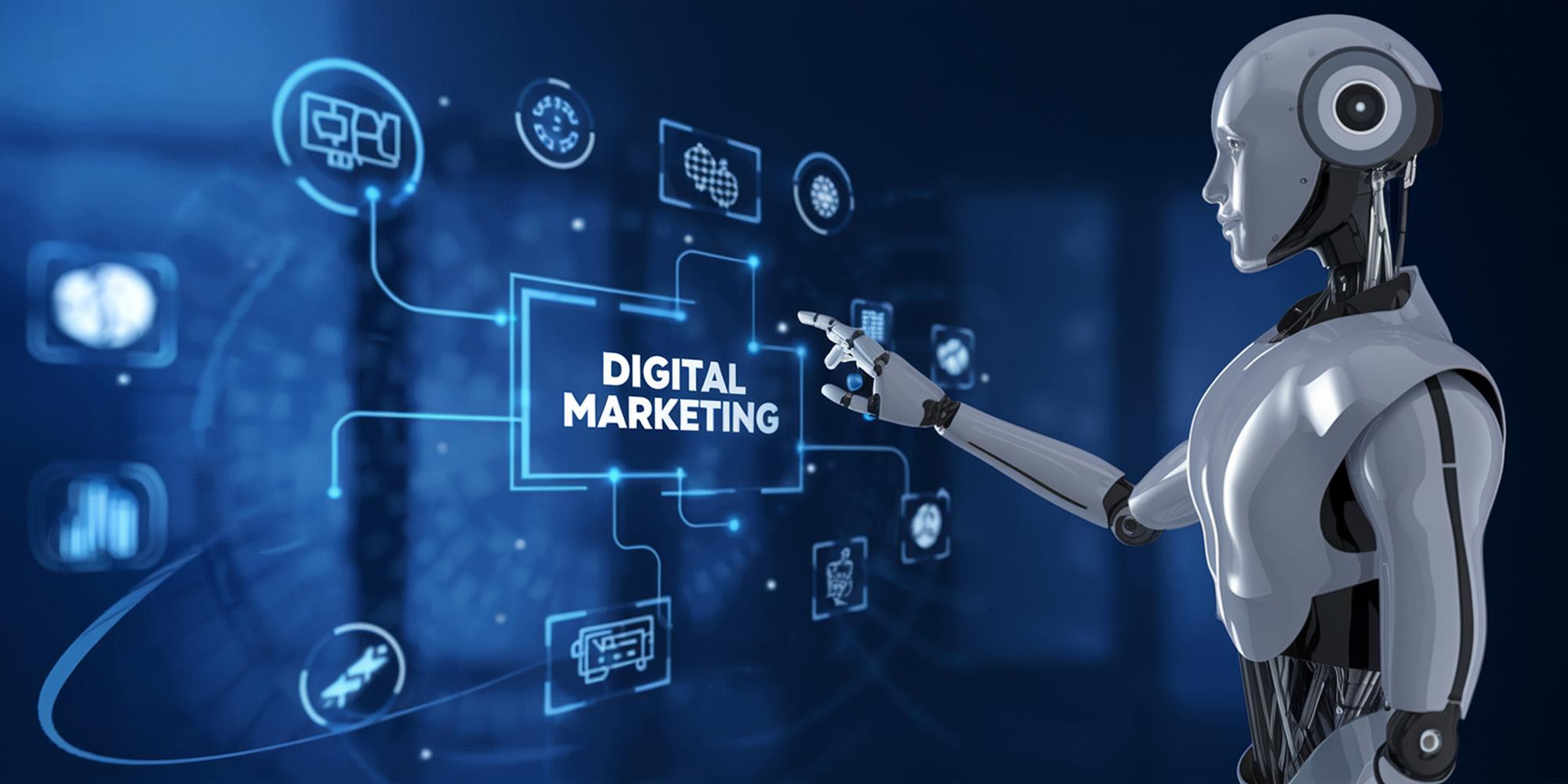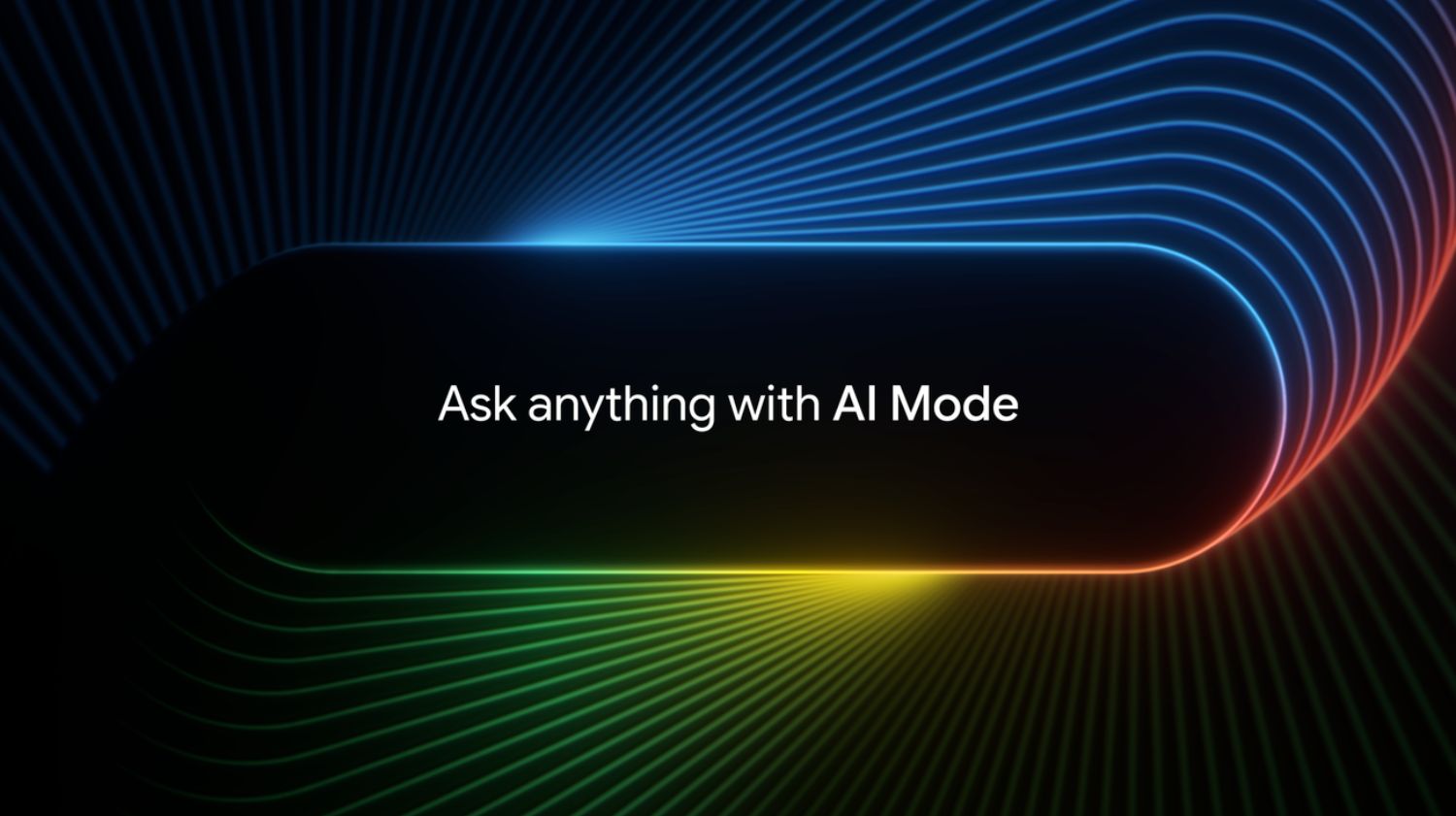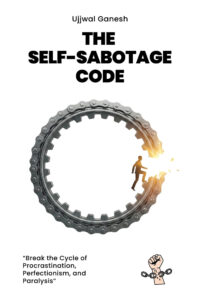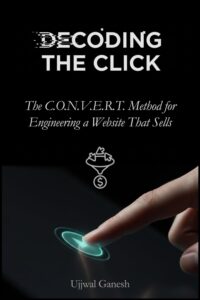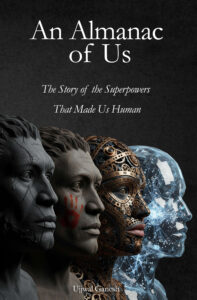Artificial intelligence (AI) is the biggest game-changer for marketing today. From writing compelling copy to identifying hidden patterns in customer behavior, AI is no longer just a buzzword; it’s becoming a must-have for marketers everywhere.
Marketing in India isn’t just about creativity; it’s a constant balancing act of scaling up, cutting costs, and standing out in one of the most dynamic and diverse markets in the world. And while we’re juggling all that, AI is emerging as the silent partner we’ve all been waiting for.
But let’s be real—AI can feel overwhelming. New tools pop up daily, and figuring out where to start can be tricky. The good news? You don’t have to be a tech wizard to make it work for your business. Whether you’re running a one-person operation or leading a team in a large enterprise, there’s an AI solution for you.
In this post, we’ll dive deep into some of the most innovative and practical use cases of AI in marketing in India. We’ll look at how businesses like yours can use AI to create better content, personalize campaigns, and make smarter decisions—all without breaking the bank. By the end of this guide, you’ll have a roadmap to start integrating AI into your marketing strategy and give your business the edge it deserves.
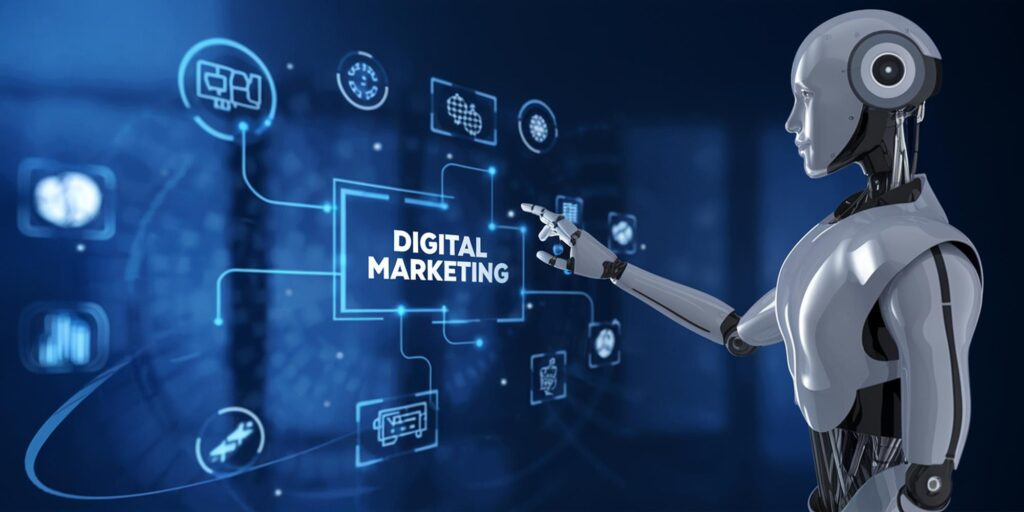
A. Enhancing Content Creation with AI
Creating high-quality content can be time-consuming, but AI simplifies the process by acting as your co-creator. From generating ideas to refining tone and structure, AI enables you to produce content that resonates with your audience.
1. Generating Blog Posts, Articles, and More
AI tools like ChatGPT and Jasper can overcome writer’s block by generating detailed outlines or full drafts for your content. Simply provide a clear prompt and context.
Example: For a blog on sustainable fashion, input: “Write a blog post titled ‘5 Ways Organic Cotton Can Revolutionize Your Wardrobe,’ including subheadings and examples.” Review the draft and add your unique brand voice.
Steps to Use Jasper:
- Log in to Jasper and choose the “Blog Post Outline” template.
- Enter the blog title and a brief description.
- Generate and refine the outline to kickstart your content.
2. Repurposing Content Across Platforms
AI tools like Descript and Copy.ai help repurpose long-form content into formats for different channels. Convert webinar transcripts into blog posts, extract social media quotes, or create punchy email copy.
Pro Tip: Use Pictory to turn blog content into engaging video snippets, ideal for Instagram reels or YouTube Shorts—especially popular among younger audiences in India.
Steps to Repurpose:
- Upload your webinar or blog content to Descript.
- Highlight key sections to extract quotes or summary points.
- Use tools like Copy.ai to reframe these points for platforms like Twitter or LinkedIn.
3. Simplifying Content for Better Readability
AI-powered writing tools like Hemingway Editor and Grammarly simplify complex content for a diverse audience.
Pro Tip: In India’s multilingual and literacy-diverse market, aim for simplicity. Ask AI tools to rewrite text for skimmability using bullet points, shorter sentences, and easier language.
Example: Paste your content into Grammarly’s “Tone Detector” to match it to your target audience’s preferences.
4. Brainstorming Creative Ideas
Use AI tools like Notion AI and Writesonic for brainstorming headlines, quirky analogies, and campaign ideas. Leverage marketing frameworks like AIDA (Attention, Interest, Desire, Action) or triggers like scarcity and trust.
Example: Planning a Diwali campaign? Prompt Writesonic: “Suggest creative campaign hooks for a Diwali home decor sale.” Customize results to fit your brand voice.
5. Editing and Polishing Content
Refine your drafts with AI editors like ProWritingAid or Grammarly. These tools catch grammatical errors, improve sentence flow, and even suggest stylistic improvements.
Best Practice: Use AI as a critique partner. For example, ask: “Rewrite this paragraph to improve clarity and engagement.” Always review AI-generated edits to ensure consistency with your brand voice.
Steps to Use ProWritingAid:
- Paste your draft into the tool and run a grammar and style check.
- Use suggestions for readability and structure improvements.
- Manually tweak the content for authenticity.
B. Personalizing Customer Experiences
In a country as diverse as India, personalization isn’t optional—it’s essential. AI allows you to create tailored experiences for different audience segments, making every interaction more relevant and impactful.
6. Tailored Messaging for Diverse Audiences
India’s diversity spans languages, lifestyles, and cultural nuances. AI tools like ChatGPT or Writesonic can help craft messages tailored to specific demographics. Use AI translation platforms like Google Translate or DeepL for regional language adaptations, and tone analysis tools like Grammarly for refining urban versus rural communication styles.
Steps:
- Segment your audience based on geographic, demographic, or psychographic data using tools like HubSpot or Zoho CRM.
- Use AI-powered copywriting tools like Jasper AI to generate personalized messages.
- Adapt content to local languages and cultural contexts with Lokalise for seamless translations.
Example: An e-commerce site selling festival decorations can send personalized emails to Mumbai customers featuring modern Diwali decor ideas, while suggesting traditional options for those in Lucknow.
7. Dynamic Personalization for Campaigns
AI enables dynamic ad content and email campaigns that evolve based on individual preferences, behavior, or location. Platforms like Dynamic Yield or Optimizely excel at real-time content personalization.
Steps:
- Analyze customer behavior through tools like Google Analytics or Adobe Analytics.
- Set up AI-powered recommendation systems using Algolia or Salesforce Einstein.
- Design region-specific content blocks for emails and ads with tools like Mailchimp.
Example: A travel company could show Goa vacation packages to adventure-seekers while promoting serene hill station retreats to family travelers based on their search history.
8. Hyper-Localized Ads and Offers
Localization in India goes beyond translations—it’s about cultural alignment. AI tools like Phrasee can craft culturally relevant ad copy, while Canva or Crello allow you to create hyper-local visuals that feature regional landmarks or festival themes.
Steps:
- Use Google Trends to identify regional preferences.
- Integrate local idioms and cultural references with the help of AI copywriting tools.
- Customize visuals for specific locations using image generators like Designhill.
Example: A fitness app could emphasize Bhangra dance for fitness in Punjab and yoga content for Maharashtra audiences, aligning the campaign with local interests.
9. Behavior-Based Customer Insights
AI doesn’t just personalize—it predicts. Tools like Klaviyo or Mixpanel analyze purchase patterns, browsing history, and social interactions to anticipate customer needs.
Steps:
- Set up predictive analytics with platforms like IBM Watson or Microsoft Azure AI.
- Segment customers based on insights into their shopping behaviors.
- Automate tailored offers or product recommendations.
Example: A grocery delivery app could suggest weekly meal plans based on a user’s previous orders, enhancing convenience and loyalty.
10. Real-Time Personalization
AI can adapt interactions on-the-fly. Tools like Bluecore or Evergage can analyze user actions in real time and deliver hyper-relevant content.
Pro Tip: Activate real-time personalization during peak shopping seasons (e.g., festive sales) to boost conversions.
Steps:
- Integrate real-time data platforms like Segment into your website or app.
- Create dynamic banners or pop-ups tailored to customer actions.
- Test the feature during high-traffic periods.
Example: If a customer browses winter jackets, instantly display a discount banner or suggest related accessories like gloves or scarves.
11. Creating Emotional Connections
AI tools like MonkeyLearn and Lexalytics analyze customer reviews, social media comments, and support transcripts to detect emotions associated with your brand.
Steps:
- Use sentiment analysis tools to understand customer emotions.
- Respond empathetically by integrating insights into your messaging.
- Offer solutions that address recurring concerns, building trust.
Example: If customers frequently express frustration with delivery times, add a message like, “We know fast delivery matters—here’s a 24-hour express option just for you.”
C. AI for Smarter SEO and SEM
In India’s competitive online market, leveraging AI for SEO and SEM can refine your strategy, optimize your ad spend, and give you an edge over competitors.
12. Optimizing Website Content for Search Engines
AI tools like SurferSEO and MarketMuse analyze your content and offer actionable insights to optimize keywords, meta tags, and internal linking. They also analyze competitors’ pages to reveal strategies that drive their success.
Example: A boutique travel agency targeting adventure seekers could use SurferSEO to optimize posts for keywords like “best trekking spots in Himachal,” improving rankings on search engines.
Steps:
- Input your URL into SurferSEO.
- Analyze the suggestions for keywords, headings, and word count.
- Implement recommended changes to boost SEO performance.
13. Spotting Content Gaps for Better Rankings
AI tools such as SEMrush and Ahrefs identify gaps in your content by analyzing competitors and audience trends.
Pro Tip: Use AI to scrape data from niche forums, FAQs, or social media to uncover underserved topics like “eco-friendly adventure travel.”
Steps:
- Run competitor analysis on SEMrush or Ahrefs.
- Identify high-performing keywords or topics they haven’t covered.
- Create in-depth, unique content to fill those gaps.
14. Making Competitor Analysis Easy
Tools like SpyFu and SimilarWeb streamline competitor analysis. They track competitors’ keywords, backlinks, and ad strategies, enabling you to improve your own campaigns.
Example: A cancer hospital in Mumbai can use SpyFu to uncover competitors’ local SEO strategies and refine their own approach for better visibility.
15. Streamlining Keyword Research
AI-powered platforms such as AnswerThePublic and Google Keyword Planner make keyword research faster and smarter by suggesting trending long-tail keywords.
Pro Tip: Target niche terms like “best rooftop restaurants in Delhi” rather than broad ones like “restaurants.”
Steps:
- Use AnswerThePublic to find popular questions around your niche.
- Export keyword suggestions and integrate them into your content.
16. Managing PPC Campaigns with Precision
AI tools like Adzooma and WordStream optimize your SEM campaigns by adjusting bids dynamically, suggesting keywords, and testing multiple ad variations for maximum ROI.
Example: A fitness app running PPC ads can use WordStream to prioritize high-converting keywords like “home workout plans in India.”
17. Creating Dynamic Ads
Platforms like AdCreative.ai personalize ads based on user behavior, preferences, or location, boosting engagement and conversion rates.
Example: An e-commerce site selling electronics could show tech-savvy users ads for “latest smartphones” and cost-conscious shoppers ads for “budget laptops.”
18. Automating SEO Audits
Tools such as Screaming Frog and Sitebulb perform in-depth SEO audits, flagging issues like broken links or slow loading speeds.
Pro Tip: Conduct regular AI-driven audits to stay compliant with Google’s algorithms and maintain peak site performance.
Steps:
- Run your website through Screaming Frog.
- Fix highlighted issues such as broken links and missing meta descriptions.
19. Predicting Trends and Search Patterns
AI platforms like TrendWatching and Google Trends analyze historical data to predict upcoming trends.
Example: If AI forecasts a surge in searches for “electric vehicles in India,” you can create blog posts, infographics, or ads tailored to the trend.
Steps:
- Use Google Trends to monitor rising topics in your niche.
- Create and publish relevant content ahead of competitors.
D. Streamlining Social Media Marketing
Managing social media can feel like a juggling act. AI helps you stay consistent, relevant, and engaging across platforms without the overwhelm.
20. Effortless Content Scheduling
AI tools like Hootsuite and Buffer make scheduling posts seamless. They analyze audience behavior and suggest the best times for maximum engagement.
Steps to Implement:
- Connect all your social media accounts to the tool.
- Analyze peak activity times using the insights dashboard.
- Schedule posts in bulk for weeks or months.
Pro Tip: Use this feature during Indian festivals like Diwali or Holi to automate culturally relevant posts at optimal times.
21. Spotting Trends and Staying Relevant
Stay ahead of the curve with AI-powered trend-spotting tools like BuzzSumo or Brand24. These platforms help you track popular hashtags, topics, and emerging discussions.
Pro Tip: For Indian marketers, AI can monitor cricket matches or local festivals, suggesting timely and relatable content ideas.
22. Crafting Eye-Catching Ads
Create high-performing ads using tools like AdCreative.ai or Canva. These platforms use AI to craft engaging visuals, layouts, and storyboards tailored to your audience.
Example: A restaurant can create sizzling dish ads for urban viewers or family dining visuals for suburban audiences.
Steps to Optimize:
- Use AI-generated templates and customize them for your brand.
- Test different versions to determine the most engaging creative.
23. Optimizing Captions and Hashtags
AI tools like RiteTag and Caption AI suggest impactful captions and trending hashtags tailored to your audience.
Pro Tip: For better reach, focus on niche hashtags like #VeganEatsDelhi instead of generic ones such as #FoodLover.
24. Engaging with Your Audience at Scale
AI chatbots like MobileMonkey or Tidio automate replies to routine queries, helping you stay responsive.
Example: A fashion brand can use AI to answer FAQs like “Do you ship to Hyderabad?” while flagging detailed product inquiries for manual attention.
Quick Start:
- Train the bot with common questions and answers.
- Use monitoring features to review flagged messages.
25. Repurposing Content Across Platforms
AI tools like Lumen5 and Piktochart make it easy to adapt one piece of content for various platforms.
Example of Repurposing:
- Convert a blog post into an infographic for Instagram.
- Create a video summary for YouTube or Facebook.
- Turn key insights into a LinkedIn carousel post.
Pro Tip: In India, platform preferences vary—LinkedIn works for professionals, while Instagram is popular among younger audiences. AI ensures each version fits the platform.
26. Analyzing Post Performance
Tools like Sprout Social or SocialBee provide in-depth analytics, helping you track what’s working and what needs improvement.
Example: An online jewelry store can analyze engagement on festive-themed posts to refine their content strategy for upcoming events.
Steps to Use:
- Review performance metrics weekly.
- Use insights to optimize future campaigns.
27. Creating Polished Visuals
AI-powered platforms like Runway ML and Designify help create professional-looking graphics and unique visuals without requiring advanced design skills.
Example: For a Holi campaign, generate vibrant, AI-designed images featuring colorful powders and festive elements.
Pro Tip: Save time by using AI templates aligned with your brand colors and style.
E. Advanced Audience Insights and Analysis
Understanding your audience is the key to effective marketing. AI dives deep into your data, uncovering patterns and insights you might otherwise miss.
28. Creating Data-Driven Buyer Personas
AI transforms raw data into meaningful buyer personas by analyzing purchase history, website interactions, and social media activity. These personas go beyond demographics to reveal behaviors, preferences, and pain points.
How to Use:
- Tools: HubSpot’s Make My Persona, Tableau, or Google Analytics 360.
- Steps:
- Gather data from CRM tools, web analytics, and social platforms.
- Input the data into your AI tool to generate personas.
- Tailor your campaigns to address the specific needs of each persona.
Example:
An online grocery store could identify one segment as budget-conscious moms looking for discounts and another as young professionals preferring time-saving meal kits. Use these personas to craft unique campaigns for each group.
29. Behavioral Segmentation for Precise Targeting
AI excels in grouping audiences based on real-time behavior, enabling hyper-specific targeting.
How to Use:
- Tools: Segment, Adobe Audience Manager, Optimizely.
- Steps:
- Monitor user interactions with your website, emails, and ads.
- Segment the audience using behavioral triggers like product searches or clicks.
- Deploy tailored ads or content for each segment.
Example:
A fitness brand might target users searching for yoga mats with yoga-related offers and those browsing gym equipment with workout packages.
30. Predicting Customer Intent
AI can analyze past behavior to predict what your customers will do next, helping you act proactively.
How to Use:
- Tools: Salesforce Einstein, Predictive Analytics by Alteryx, Amazon Personalize.
- Steps:
- Identify recurring customer behaviors (e.g., frequent orders or product interest).
- Set triggers for specific actions like reminders or offers.
Example:
An e-commerce platform could remind a customer to reorder a favorite product, like coffee pods, and include a discount.
31. Spotting Hidden Trends and Insights
AI tools can detect emerging trends in customer preferences or product demand.
How to Use:
- Tools: Brandwatch, Sprout Social, BuzzSumo.
- Steps:
- Use social listening tools to monitor discussions around your industry.
- Identify shifts in preferences or interests.
- Align marketing strategies with these trends.
Pro Tip:
A skincare brand could spot growing interest in “natural remedies” and launch products or content around this theme.
32. Analyzing Customer Feedback
AI turns customer feedback from reviews, surveys, and social comments into actionable insights.
How to Use:
- Tools: MonkeyLearn, Qualtrics XM, Google Cloud Natural Language AI.
- Steps:
- Gather feedback data from various sources.
- Use sentiment analysis tools to uncover trends and recurring themes.
Example:
A restaurant chain could discover that customers love their desserts but dislike slow service, informing both marketing and operational improvements.
33. Mapping the Customer Journey
AI creates detailed maps of the customer journey, pinpointing touchpoints where customers engage or drop off.
How to Use:
- Tools: Mixpanel, Pendo, Kissmetrics.
- Steps:
- Map out key touchpoints using journey analytics tools.
- Optimize touchpoints with personalized content or retargeting.
Pro Tip:
Use these insights to design drip email campaigns aligned with customer needs at each stage.
34. Audience-Specific Campaign Creation
AI identifies the right messaging, tone, and format for each audience segment.
How to Use:
- Tools: Canva Magic Write, Copy.ai, Phrasee.
- Steps:
- Segment your audience.
- Use AI-powered content generators to craft personalized messaging.
Example:
A financial services company can create campaigns tailored to first-time investors, seasoned traders, and retirees, addressing their unique goals.
35. Real-Time Insights for Quick Decision-Making
AI delivers actionable insights in real time, enabling rapid adjustments to your campaigns.
How to Use:
- Tools: Google Analytics 4, Looker Studio, DataRobot.
- Steps:
- Monitor campaigns with real-time analytics tools.
- Identify trends or issues and adapt instantly.
Example:
During a festive sale, an online retailer can track trending products and adjust promotions to boost sales.
F. Efficient Content and Campaign Research
36. Spotting Content Gaps
Why does your competitor’s blog rank higher? Likely because they’re covering topics or perspectives you’ve missed. AI tools like BuzzSumo (link) and Semrush Topic Research (link) analyze top-performing content in your niche to identify underserved areas.
Example:
Your wellness brand’s blog might focus on general meditation tips, but AI reveals a lack of content around “guided meditations for busy professionals.” This insight fuels your next winning content idea.
Pro Tip: Use AI tools such as AnswerThePublic (link) to explore user questions on Quora, Reddit, or Google’s “People Also Ask” section for inspiration.
37. Finding Low-Competition Keywords
SEO often boils down to targeting the right keywords. AI-powered tools like Ubersuggest (link) and Ahrefs Keywords Explorer (link) suggest long-tail keywords with lower competition and higher intent, making it easier to rank for terms that drive traffic.
Example:
Instead of competing for “yoga poses,” AI might recommend “easy yoga poses for seniors,” a niche but highly relevant keyword for your audience.
Step-by-Step:
- Enter your main topic into an AI keyword tool.
- Filter results by low competition and high search intent.
- Incorporate these keywords naturally into your content.
38. Trend Prediction for Future Content Needs
In a fast-moving digital landscape, staying ahead is critical. AI tools like Google Trends (link) and Exploding Topics (link) predict emerging trends by analyzing historical and current data.
Example:
A fashion brand identifies the rising interest in “sustainable clothing” and creates content around this topic before it goes mainstream.
Pro Tip: Set up trend alerts in tools like TrendHunter (link) to stay ahead of the curve.
39. Competitor Campaign Analysis
Tracking competitor strategies manually is overwhelming. AI tools like Adbeat (link) and SimilarWeb (link) automate the analysis of competitor ads, content, and strategies, helping you identify what works for them and where they fall short.
Pro Tip: Use AI to analyze competitor ads for emotional tones, calls-to-action, and formats. Apply these learnings to craft standout campaigns that capture your audience’s attention.
40. Streamlining Research for Buyer Personas
Developing accurate buyer personas can be daunting. AI tools like HubSpot’s Make My Persona (link) and Crystal Knows (link) simplify this by analyzing customer data, purchase behavior, and social interactions to create detailed profiles.
Example:
A plant-based snack startup uses AI to identify key personas, such as health-conscious millennials seeking organic products or eco-friendly consumers reducing their carbon footprint.
Pro Tip: Leverage Sprinklr (link) or Zoho CRM’s AI tools (link) to consolidate customer data into actionable insights.
41. Generating Topic Ideas
AI can be your brainstorming buddy. Tools like ChatGPT (link) and Frase.io (link) generate fresh content ideas based on trending topics, audience questions, or gaps in your existing material.
Pro Tip: For highly engaging ideas, prompt AI to generate topics using specific frameworks like AIDA (Attention, Interest, Desire, Action) or problem-solving strategies.
Example Prompt:
“Generate blog topics for a wellness brand using the AIDA framework.”
42. Data-Driven Ad Campaign Insights
Analyze historical campaign performance with AI tools like Adzooma (link) or Google Ads Insights (link) to determine what worked—and what didn’t. Use these insights to fine-tune your next campaign.
Example:
An e-commerce store identifies that product-specific ads with clear CTAs outperform generic brand-awareness ads, refining future strategies for maximum ROI.
43. Real-Time Research on Audience Preferences
Why wait for quarterly reports when AI provides real-time audience insights? Tools like Brandwatch (link) and Hootsuite Insights (link) analyze live data to identify trends, preferences, and engagement hotspots.
Example:
If AI detects a surge in interest around “home workout equipment,” a fitness retailer can immediately launch targeted content, ads, or social posts to capture this interest.
Pro Tip: Use real-time alerts from Google Alerts (link) or Talkwalker (link) to stay agile in your marketing efforts.
G. Automating Repetitive Tasks
44. Automating Customer Support
AI-powered chatbots like Zendesk AI or Tidio have revolutionized customer service. These tools handle FAQs, provide instant replies, and guide users through simple processes like order placements or tracking shipments—all while working 24/7.
Steps to Implement:
- Select a chatbot platform such as Tidio or Intercom.
- Train the chatbot with common queries and responses.
- Customize the chatbot’s tone to align with your brand identity.
- Use analytics from these tools to continuously improve the responses.
Example: An e-commerce store can use AI to answer “What’s your return policy?” while routing complex issues to human agents.
45. Streamlining Email Marketing
AI tools like Mailchimp or ActiveCampaign automate email creation, audience segmentation, and campaign scheduling. AI also predicts the best times to send emails for higher open rates.
Steps to Implement:
- Use Mailchimp’s AI Assistant to generate engaging subject lines and content templates.
- Segment your audience based on behavior using tools like ActiveCampaign.
- Schedule campaigns for optimal times.
Example: A travel agency can send personalized honeymoon deals to newlyweds based on previous inquiries or bookings.
46. Social Media Scheduling and Responses
AI-powered platforms like Hootsuite and Buffer schedule posts at optimal engagement times and manage responses to routine messages.
Steps to Implement:
- Use Hootsuite’s content calendar to plan posts.
- Automate responses to FAQs with tools like ManyChat for Instagram or Facebook.
Example: A café can schedule daily specials while automating responses to DMs like “What are today’s timings?”
47. Lead Management Made Simple
AI tools such as HubSpot or Zoho CRM score leads by analyzing interactions and behaviors, allowing your sales team to focus on high-potential prospects.
Steps to Implement:
- Integrate AI lead-scoring tools into your CRM.
- Use HubSpot to track user activity like pricing page visits or webinar attendance.
Example: A SaaS company identifies leads who repeatedly visit product demo pages, signaling high interest.
48. Content Moderation
AI tools like Grammarly or Microsoft Content Moderator flag inappropriate comments, respond with pre-approved messages, or highlight feedback requiring attention.
Steps to Implement:
- Set moderation rules using Microsoft Content Moderator.
- Customize automatic replies for common review types.
Pro Tip: For online communities, AI helps maintain positivity and reduces manual oversight.
49. Data Entry and Reporting
Tools like Zapier and Google Data Studio automate data collection and report generation, saving hours of manual effort.
Steps to Implement:
- Set up Zapier to pull data from sources like Google Analytics or Facebook Ads.
- Use Google Data Studio to create automated dashboards for real-time insights.
Example: A digital agency automates monthly performance reports for clients, significantly cutting down on manual work.
50. Inventory and Supply Chain Management
AI tools like TradeGecko (now part of QuickBooks Commerce) or Zoho Inventory help track stock levels, predict demand, and automate restocking.
Steps to Implement:
- Use Zoho Inventory for demand forecasting based on sales trends.
- Set automatic reorder thresholds to prevent stockouts.
Example: A fashion retailer predicts festive season demand for specific styles and ensures timely restocking.
H. Improving Visual and Video Content
Eye-catching visuals and videos are essential for grabbing attention, and AI simplifies the process significantly.
51. Designing Eye-Catching Graphics
AI tools like Canva (canva.com) and Adobe Express (adobe.com/express) can generate polished graphics that align with your brand. These tools let you upload brand colors, fonts, and style preferences to maintain consistency across platforms. Features like automatic resizing for Instagram Stories, Facebook posts, and other formats save time.
- How-to: Use Canva’s “Brand Kit” to store your assets and quickly create banners, infographics, or social posts.
- Example: A boutique fashion brand can design promotional banners showcasing their collection, formatted perfectly for various channels.
52. Editing Photos Like a Pro
With tools like Remove.bg (remove.bg) and Luminar Neo (skylum.com), you can edit photos effortlessly. These tools can remove backgrounds, enhance colors, and apply filters in minutes.
- Pro Tip: Use Remove.bg to eliminate cluttered backgrounds and Luminar Neo’s AI enhancements to make images pop.
- Example: A bakery can enhance cake photos, making them irresistibly appealing for Instagram.
53. Creating Engaging Videos
AI video tools such as InVideo (invideo.io) and Pictory (pictory.ai) enable quick video creation. They automate tasks like transitions, text overlays, and music selection, making professional-looking videos accessible even for non-filmmakers.
- How-to: Use InVideo’s templates to create workout tutorials or promotional videos.
- Example: A fitness app can use AI to add subtitles and smooth transitions for a polished look.
54. Repurposing Long-Form Videos
AI tools like Descript (descript.com) and Vidyo.ai (vidyo.ai) can analyze webinars or interviews and extract key moments for short, shareable clips.
- Pro Tip: Use Descript’s “Overdub” to edit or re-record audio seamlessly and Vidyo.ai for generating captions automatically.
- Example: A marketing agency can create TikTok-ready clips from client interviews.
55. Generating Visual Content Ideas
AI-driven platforms like ChatGPT (openai.com) and DeepBrain (deepbrain.io) analyze industry trends and past campaigns to inspire new visual concepts. Use them to brainstorm ideas for carousel posts, interactive videos, or infographics.
- Example: A tech company can brainstorm ways to visualize how their product simplifies complex tasks.
56. Optimizing Visual Content for Performance
Tools like TubeBuddy (tubebuddy.com) and AdCreative.ai (adcreative.ai) analyze the performance of your visuals and suggest improvements.
- How-to: Use TubeBuddy to optimize YouTube thumbnails for higher click-through rates or AdCreative.ai to adjust layouts for better Facebook ad engagement.
- Example: A travel agency identifies that scenic beach shots perform better than text-heavy visuals and adjusts their strategy accordingly.
57. Creating AI-Generated Visuals
Platforms like DALL·E 2 (openai.com/dall-e) and Artbreeder (artbreeder.com) let you generate unique visuals, from abstract designs to realistic imagery.
- Example: An eco-friendly brand creates nature-themed AI-generated art for an Earth Day campaign.
58. Personalizing Visuals for Different Audiences
Dynamic personalization tools like Jivox (jivox.com) allow you to tailor visuals to audience segments based on regional or seasonal preferences.
- Example: A restaurant chain can create winter-themed ads for northern audiences and summer visuals for coastal regions, all automated through AI.
I. Marketing Strategy Assistance
Crafting a winning marketing strategy requires careful planning, thoughtful execution, and the ability to pivot quickly when things don’t go as planned. But with so many moving parts—customer insights, campaign ideas, content calendars—it’s easy to feel overwhelmed. Enter AI, your go-to assistant for streamlining strategy development and ensuring every campaign is data-driven, timely, and effective.
59. Building Smarter Marketing Funnels
AI removes guesswork from building marketing funnels by analyzing audience behavior and predicting their journey from awareness to conversion.
Example: Tools like HubSpot or ActiveCampaign can recommend adding educational content, such as explainer videos, at the awareness stage, followed by testimonials and discount offers at the decision stage.
Pro Tip: Use AI insights to refine your funnels regularly, adapting to changing customer preferences and market dynamics.
60. Generating Campaign Ideas
AI tools like ChatGPT or Crayon can analyze industry trends, competitor strategies, and historical data to brainstorm innovative campaign concepts.
Example: A food delivery service can use AI to generate seasonal themes like “Rainy Day Comfort Foods,” targeting customer preferences with personalized offers based on past orders.
How-To: Enter key details about your brand, target audience, and past campaign performance into these tools for relevant suggestions.
61. Optimizing Campaign Timelines
AI tools such as Optimizely or Mailchimp analyze historical data and audience activity to recommend the best times for launching campaigns, sending emails, or posting on social media.
Pro Tip: In India, align campaigns with regional festivals and shopping hours for better resonance. For instance, launching campaigns in the evening during Diwali shopping peaks could maximize engagement.
62. Improving Multi-Channel Campaigns
AI platforms like Hootsuite or Sprinklr centralize multi-channel campaign management, ensuring consistent messaging while tailoring content for each platform.
Example: An electronics brand can use YouTube for detailed product reviews and Instagram for visually engaging teasers. AI can even recommend budget allocation per channel for optimal ROI.
63. Data-Driven Strategy Adjustments
AI enables real-time adjustments by analyzing performance data and identifying areas of improvement.
Example: Using tools like Google Analytics or AdRoll, a travel agency can detect underperforming ads for beach vacations and reallocate resources to hill station packages.
How-To: Set up automated alerts to receive real-time insights and act quickly to optimize your campaigns.
64. A/B Testing Made Effortless
AI simplifies A/B testing by automatically generating variations and analyzing their performance.
Example: Tools like Unbounce or VWO can test different ad creatives or email subject lines, such as “Discounts Galore” versus “Your Style Upgrade Awaits,” to determine which drives higher engagement.
65. Audience-Specific Messaging
Personalization is key. AI tools like Persado or Segment analyze audience interests and demographics to craft messages that resonate.
Example: A fitness studio can run AI-powered campaigns targeting gym-goers for strength training and yoga enthusiasts for stress relief, each with customized offers.
66. Forecasting Campaign Success
AI tools such as Salesforce Einstein or Marketo predict campaign success by analyzing historical data and market trends, helping you set realistic goals and allocate budgets effectively.
Pro Tip: Use AI-generated forecasts to justify budgets and guide long-term planning to stakeholders.
67. Creating Real-Time Dashboards
AI-powered dashboards provide a comprehensive view of campaign performance, tracking ROI, engagement, and conversions in real time.
Example: A digital marketing agency using Tableau or Datorama can monitor client campaigns and generate automated, shareable reports.
How-To: Customize dashboards to prioritize metrics most relevant to your goals, ensuring actionable insights at a glance.
J. Lead Generation and Scoring
Generating and prioritizing high-quality leads is a perennial challenge for marketers. With AI, you can automate the lead generation process, focus on promising prospects, and optimize your marketing funnel for better ROI.
68. Identifying High-Quality Leads
AI leverages user behavior, purchase history, and engagement metrics to predict which prospects are most likely to convert. This data-driven approach helps marketers focus their energy on high-potential leads.
Example:
An ed-tech company could use HubSpot or Marketo to analyze website interactions, identifying students who frequently browse course pages but haven’t enrolled yet. Personalized offers like a limited-time discount can significantly boost conversion rates.
Pro Tip: Use tools like Zoho CRM or Salesforce Einstein to integrate AI-powered lead tracking across the customer journey, ensuring timely follow-ups.
69. Creating Hyper-Targeted Lead Magnets
AI enables the creation of lead magnets tailored to audience preferences, such as quizzes, webinars, or eBooks. Tools analyze user behavior to ensure your offer resonates with specific needs.
Example:
A financial services firm could use Typeform integrated with ChatGPT to create a quiz, “What’s Your Investment Personality?” AI then segments users based on quiz results, triggering personalized follow-up content.
Steps:
- Use SurveyMonkey or Outgrow to design an engaging quiz.
- Employ ActiveCampaign to automate segmentation and personalized email delivery.
70. Scoring Leads for Better Prioritization
AI ranks leads based on conversion likelihood using metrics like email engagement, website visits, and demographics. Scored leads help sales teams prioritize their outreach efforts effectively.
Example:
A SaaS company could use LeadSquared or Zoho SalesIQ to assign high scores to demo requesters while assigning medium scores to those who downloaded a whitepaper, tailoring the engagement strategy for each group.
71. Optimizing Lead Nurturing Campaigns
AI personalizes and automates lead nurturing through email sequences, retargeting ads, and dynamic content. It adapts messaging and timing based on user interactions, maintaining engagement without overwhelming prospects.
Example:
An online fitness platform could use Mailchimp with AI-powered recommendations to send personalized emails, like yoga workout tips for users browsing the “Yoga” section, or discounts for those abandoning the subscription page.
Pro Tip: Combine AI with Google Ads or Facebook Pixel for advanced retargeting.
72. Predicting Lead Conversion Potential
AI predicts conversion likelihood by analyzing historical data and interaction patterns, enabling more efficient resource allocation.
Example:
A luxury real estate agency could use Clari to identify that leads attending virtual open houses are 40% more likely to book a site visit, focusing their efforts accordingly.
73. Generating Lists for Experiments
AI ensures unbiased and relevant segmentation for A/B testing and campaign experiments.
Example:
Use Adobe Marketo Engage to split leads into distinct groups, like repeat visitors and first-time users, and experiment with tailored messaging for each.
74. Using Real-Time Insights for Lead Follow-Up
AI provides real-time updates for better lead follow-up, ensuring no opportunity is missed.
Example:
A digital marketing agency could use Intercom or Drift to alert their sales team when a lead downloads a case study, enabling immediate follow-up with a customized proposal.
Steps:
- Set up real-time alerts in your CRM (e.g., Pipedrive) for specific user actions.
- Use Zapier to automate notifications for timely responses.
75. Segmenting Leads with Precision
AI-driven segmentation enables marketers to create highly specific audience groups using behavioral, demographic, or psychographic data.
Example:
An online learning platform could use Segment or Klaviyo to group leads into “tech enthusiasts” or “career switchers” based on course preferences and interaction history, optimizing content and offers.
K. Real-Time Campaign Optimization
Launching a campaign is just the beginning—what truly determines its success is how well you adapt and optimize as it runs. In India’s fast-paced market, where trends shift quickly and audience behaviors evolve, waiting until the campaign ends to analyze its performance isn’t an option. AI elevates campaign optimization by providing real-time insights and enabling instant adjustments for maximum impact.
76. Analyzing Campaign Performance in Real Time
Tools to Use: Google Analytics, HubSpot Marketing Hub, Hootsuite Insights
AI-powered analytics tools track key metrics like click-through rates, engagement, and conversions in real-time. Instead of waiting for a post-campaign report, you get actionable insights immediately, helping you identify what’s working and what needs improvement.
Steps:
- Set up your analytics tool (e.g., Google Analytics) to monitor specific KPIs for your campaign.
- Use tools like HubSpot or Hootsuite to create real-time dashboards for a snapshot of your performance.
- Act on insights—such as reworking underperforming creatives—without delay.
Example: A retail brand running a festive sale can use AI to track which products are generating the most clicks and pivot focus to those items mid-campaign.
77. Adjusting Ad Spend Dynamically
Tools to Use: Adzooma, Skai, MarinOne
AI analyzes ad spend in real time, reallocating your budget to channels, regions, or demographics delivering the best ROI. This ensures efficient spending without wasting resources on underperforming segments.
Steps:
- Link your ad accounts (Google, Facebook, etc.) to an AI tool like Adzooma.
- Monitor budget allocation suggestions based on performance metrics.
- Approve or automate reallocation to optimize ROI.
Example: A food delivery app promoting metro-city discounts could use AI to detect higher conversions in Bangalore and allocate more budget there while reducing spend in slower regions.
78. Optimizing Ad Creatives on the Fly
Tools to Use: AdCreative.ai, Canva Pro, Designhill Studio
AI can tweak campaign elements live, such as headlines, visuals, or call-to-action buttons, ensuring ads always perform at their peak.
Steps:
- Use a tool like AdCreative.ai to generate multiple creative variations.
- Let the AI test these variations in real-time for performance.
- Implement the best-performing creative across your campaign.
Example: A travel agency running Google Ads for weekend getaways could use AI to test variations like “Book Your Escape Now!” versus “Limited Weekend Deals” and identify which drives more clicks.
79. Personalizing Campaigns in Real Time
Tools to Use: Dynamic Yield, Adobe Target
AI personalizes live campaigns by adapting ads or messaging based on user interactions, ensuring relevance and engagement at every touchpoint.
Steps:
- Integrate tools like Dynamic Yield to track user behavior.
- Create rules to serve tailored creatives based on browsing patterns.
- Monitor performance and iterate on personalization strategies.
Example: An e-commerce site running a winter sale can show different banners to users browsing jackets versus those interested in scarves.
80. Predicting Campaign Success Mid-Way
Tools to Use: Pecan AI, Alteryx, Google Cloud AI
AI uses historical and live data to predict campaign outcomes, enabling proactive adjustments like refining targeting or testing new formats before it’s too late.
Steps:
- Train your AI tool with historical campaign data.
- Monitor real-time predictions for metrics like engagement and conversions.
- Use insights to tweak targeting or creative strategies proactively.
Pro Tip: If your AI tool predicts low performance, act immediately to adjust targeting or refresh creatives based on its suggestions.
81. Running Automated A/B Tests
Tools to Use: Optimizely, VWO, Crazy Egg
AI accelerates A/B testing by running multiple tests simultaneously and analyzing results in real time. It quickly identifies the best-performing variations for maximum impact.
Steps:
- Define test variations (e.g., two different CTAs).
- Use an AI tool like Optimizely to deploy and monitor tests across platforms.
- Implement the top-performing variation immediately.
Example: A SaaS company promoting a free trial might test “Sign Up Now” versus “Try It Free Today” and let AI determine which generates more leads.
82. Responding to Audience Behavior Instantly
Tools to Use: Sprinklr, Buffer Analyze, Zoho Social
AI tracks audience behavior—what they’re clicking, skipping, or dropping off—and helps you tweak campaigns in response.
Steps:
- Use tools like Sprinklr to track campaign engagement metrics.
- Analyze insights to identify drop-offs or underperforming content.
- Adjust messaging or offers in real-time to re-engage users.
Example: A restaurant chain running an online reservation campaign might notice incomplete bookings and introduce a 10% discount to boost conversions.
83. Scaling Campaigns Based on Performance
Tools to Use: Google Ads Performance Planner, Facebook Ads Manager, AI-Powered Taboola
AI helps scale successful campaigns by increasing ad spend, expanding audiences, or rolling out similar creatives across platforms.
Steps:
- Use tools like Google’s Performance Planner to identify scaling opportunities.
- Increase budgets or expand targeting based on AI insights.
- Replicate winning strategies across new channels or platforms.
Pro Tip: Identify specific parameters—like keywords or demographics—driving success and replicate them for future campaigns.
Conclusion
Today AI is no longer a futuristic buzzword—it’s a tool every online marketer should embrace. In this guide, we have explored 80+ Use cases of AI in marketing with examples that can help you revolutionize your marketing strategies. This will empower you to work smarter, connect deeper, and grow faster in India’s dynamic market.
You should start small. As you see results, expand its role in your strategy. Remember, AI isn’t here to replace your creativity—it’s here to amplify it.
Dive in, explore AI tools, and take your marketing to the next level. The future of marketing is here—don’
